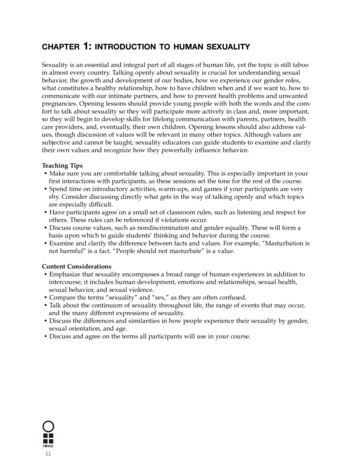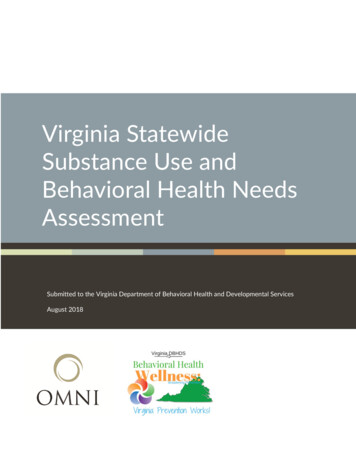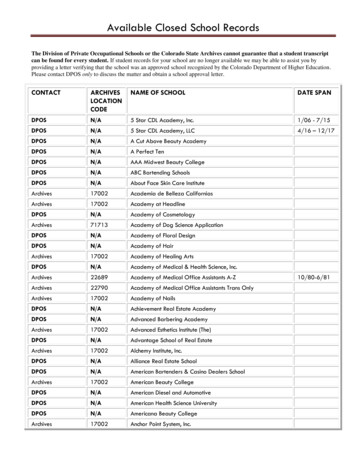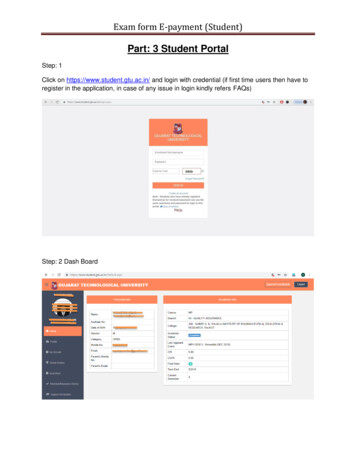
Transcription
CHAPTER1:INTRODUCTION TO HUMAN SEXUALITYSexuality is an essential and integral part of all stages of human life, yet the topic is still tabooin almost every country. Talking openly about sexuality is crucial for understanding sexualbehavior, the growth and development of our bodies, how we experience our gender roles,what constitutes a healthy relationship, how to have children when and if we want to, how tocommunicate with our intimate partners, and how to prevent health problems and unwantedpregnancies. Opening lessons should provide young people with both the words and the comfort to talk about sexuality so they will participate more actively in class and, more important,so they will begin to develop skills for lifelong communication with parents, partners, healthcare providers, and, eventually, their own children. Opening lessons should also address values, though discussion of values will be relevant in many other topics. Although values aresubjective and cannot be taught, sexuality educators can guide students to examine and clarifytheir own values and recognize how they powerfully influence behavior.Teaching Tips Make sure you are comfortable talking about sexuality. This is especially important in yourfirst interactions with participants, as these sessions set the tone for the rest of the course. Spend time on introductory activities, warm-ups, and games if your participants are veryshy. Consider discussing directly what gets in the way of talking openly and which topicsare especially difficult. Have participants agree on a small set of classroom rules, such as listening and respect forothers. These rules can be referenced if violations occur. Discuss course values, such as nondiscrimination and gender equality. These will form abasis upon which to guide students’ thinking and behavior during the course. Examine and clarify the difference between facts and values. For example, “Masturbation isnot harmful” is a fact. “People should not masturbate” is a value.Content Considerations Emphasize that sexuality encompasses a broad range of human experiences in addition tointercourse; it includes human development, emotions and relationships, sexual health,sexual behavior, and sexual violence. Compare the terms “sexuality” and “sex,” as they are often confused. Talk about the continuum of sexuality throughout life, the range of events that may occur,and the many different expressions of sexuality. Discuss the differences and similarities in how people experience their sexuality by gender,sexual orientation, and age. Discuss and agree on the terms all participants will use in your course.11
SELECTED LESSON PLAN1.1: UNDERSTANDING HUMAN SEXUALITYSOURCEReproductive Health and Sexuality Education Curriculum of the State Pedagogical University,Adolescent Reproductive Health Project of the United Nations Populations Fund (UNFPA),Ulaanbaatar, Mongolia, 2002. Translated by Tumurbat Basaantseren. Adapted with permission.Suitable for ages 15 to 18SummaryThis lesson is a particularly good opener because it immediately engages participants in discussion and begins to define sexuality, breaking it down into five components: human development, sexual health, relationships and emotions, sexual behavior, and sexual violence. It mayalso be used for introducing the concept of sexuality to school administrators, parents, andother adults. Participants begin by discussing the difference between sex and sexuality, whichallows the facilitator to gauge participants’ prior knowledge and correct any misinformation.After the group discussion, participants break into small groups and work together to organizea jumbled list of subtopics into categories. This gives them an opportunity to think about howand why various aspects of sexuality fit together. The facilitator then works with participantsto introduce and briefly discuss some of those aspects, including similarities and differencesin the way that women and men experience sexuality and common misconceptions aboutsexuality.Teaching Notes Familiarize yourself with the model used and think about the reasons why each subtopicbelongs where it is placed on the model. Develop questions to ask if you need to guide participants to the correct placement.Adapting the Lesson Look at the examples that are given for how the components are linked through pubertyand adapt them to your culture.12
SELECTED LESSON PLAN1.1: UNDERSTANDING HUMAN SEXUALITYUNDERSTANDING HUMAN SEXUALITY (45 MIN)Adapted from Reproductive Health and Sexuality Education Curriculum of theState Pedagogical University, Ulaanbaatar, Mongolia, published by theAdolescent Reproductive Health Project of the UNFPAAimTo broaden participants’ understanding of human sexuality by introducing itscomponents and subtopicsObjectivesBy the end of this session participants will be able to:1. Give a definition of “human sexuality”2. Name the five main components of sexuality3. Name two or three subtopics of each componentKey Messages1. There are many different ways to define the term “sexuality.”2. Sexuality is an integral part of being human. It begins before birth and lasts untilthe end of life.3. Sexuality is essential to the continued existence of humanity.4. Sexuality is not just about the process of reproduction. Sexual behavior is onlyone part of sexuality.5. To simplify the term “human sexuality,” it can be split into the followingfive components: Human Development Sexual Health Relationships and Emotions Sexual Behavior Sexual Violence6. The components of sexuality and their subtopics are interconnected.Materials A stack of large cards or paper, suitable for making signs Tape A copy of the handouts “An Explanation of the Components of Sexuality” and“The Components of Sexuality” for each participant, if possiblePreparation1. On five of the cards print the main components of sexuality, one per card: HumanDevelopment, Relationships and Emotions, Sexual Behavior, Sexual Health, and SexualViolence. Tape the five cards on the walls around the room, leaving plenty of space betweeneach card.LESSON PLAN131.1
2. Print the following phrases on the remaining cards, one per card: Reproductive Physiology and Anatomy Puberty Reproduction Climacteric and Menopause Body Image Sexual Orientation Gender Identity and Roles Families Friendships Loving, Liking, and Caring Attraction and Desire Flirting Dating and Courtship Intimacy Marriage and Lifetime Commitments Raising Children Contraception Abortion Reproductive Tract Infections, STIs and HIV/AIDS Genital Care and Hygiene Breast Self-Exam Testicular Self-Exam Prevention of STIs/HIV and Unwanted Pregnancy Prenatal Care Infertility Sexual Dysfunction Sexual Abuse Incest Rape Manipulation through Sex Sexual Harassment Gender Discrimination Partner or Domestic Violence Harmful Practices Masturbation Kissing Touching and Caressing Sexual Intercourse Abstinence Pleasure and Human Sexual Response FantasyMix these cards up and divide them into five sets of approximately the same number.LESSON PLAN1.114
IntroductionIntroduce the topic briefly by saying that before learning about sexuality, one needs truly tounderstand what “sexuality” means, and that you all will spend the next hour talking aboutand exploring what sexuality is and how it is a part of every human life.Activity 1: The Difference Between Sex and Sexuality1. Write on the board “What is sex?” and “What is sexuality?” Ask participants how they wouldanswer these questions. Then ask what the difference is between them, if any. Participantsmay have different opinions. For example, some of them may think these two things bothrefer to sexual intercourse, while others may think sexuality is a much broader concept.2. Using the participants’ opinions, bring out the idea that sexuality is a much broader conceptthan sexual intercourse.Activity 2: Components of Human Sexuality1. Tell participants that you are now going to explore what sexuality consists of in more depth.Point to the five signs that you have posted on the walls and tell them that sexuality can bebroken down into five main components or areas: Human Development, Relationships andEmotions, Sexual Behavior, Sexual Health, and Sexual Violence.2. Divide participants into five roughly even groups, and give each group a set of cards. Thegroup should read each card, discuss it, and decide which of the five components it best fitsunder. Tell the participants to tape each card under the component they think it belongs to.3. After the groups have finished, bring them back together. Starting with one of thecomponents, go through each card taped under it one at a time and generate a shortdiscussion. For each card: Ask the group as a whole: “Do you think this card belongs under this component?” If there is any disagreement, ask the group that placed it there: “Why did you decideto put this card here?” Ask others what they think. If they don’t agree, ask: “Why not? Where do you thinkit belongs?” Ask questions and use the participants’ comments and ideas to guide them to thecorrect placement. If a card has been misplaced, have a participant put it under the right component.Treat each card the same way regardless of whether it is correctly or incorrectlyplaced to generate discussion. Use information in the handout “An Explanation ofthe Components of Sexuality” to supplement the discussion and clarify points.However, do not get into a long discussion about any of the cards at this point. Ifnecessary, tell participants that you will look more closely at these components laterin the course. If there is a lot of disagreement, you can note that many of the topics overlap andpeople may have different ideas about where they go, but you are trying to find theplace where it fits best.4. Ask participants the following questions: ”What surprised you about this activity?” “What thoughts and feelings did you have while doing this activity?” “Looking at these components, what part does sexual intercourse play in sexuality?”(Answer: A small part, it is only one subtopic of one of the five components.) “What do you notice about sexuality?” (Answer: It is a very broad topic, has a lot ofsubtopics, is complex, etc.)LESSON PLAN151.1
“Which component do you already know the most about? Why do you think that isthe case?” “Which one raises the most questions for you? Why do you think that is the case?”5. Explain to participants that each of these components has overlapping parts. Note thatPuberty is under the component Human Development since it is a process that humanbeings go through as they grow up. Ask participants if they can name one or more parts ofthe other components that a teenager going through puberty might experience. (Forexample, under Relationships, participants might identify Love, Dating, and IntimateFriendships; under Sexual Behavior, Kissing, Touching, Holding Hands, and Masturbation;under Sexual Health, Sexual Hygiene, Breast and Testicular Self-Exam, Contraception Use,and Abortion; under Sexual Violence, Sexual Abuse, Rape, and Gender Discrimination.)Conclusion1. Conclude the session by asking participants the following questions: “Based on what you learned, what are some similarities in the ways in which menand women experience their sexuality?” “What differences are there in the ways men and women experience their sexuality?” “What cultural differences (differences based on race, religion, or national origin)have you observed in the way people express their sexuality?” (Examples mightinclude differences in dressing, flirting, gender-restricted behavior, toilet training ofchildren, dealing with menstruation or first ejaculations, courtship and marriage, etc.)2. Ask participants to take turns finishing one of the following sentence stems: This session taught me that . . . One thing I never thought of in relation to sexuality is . . .3. If you have copies of the two handouts for participants, give them out now.LESSON PLAN1.116
HANDOUT: AN EXPLANATION OF THE COMPONENTS OF SEXUALITYHuman DevelopmentHuman development involves the interrelationship between physical, emotional, social, andintellectual growth. This component includes:Reproductive Physiology and Anatomy: The parts of the body that form the reproductive andsexual systems and their functions. Although the whole body is involved in human sexuality,these systems are central to sexuality and to understanding puberty, menstruation, erections,wet dreams, reproduction, and sexual pleasure.Growth and Development: Includes the following key processes related to sexuality: Puberty: The physical and emotional changes that occur when the body matures duringadolescence, including the development of secondary sex characteristics (such as broad hipsand facial hair) and the maturing of the reproductive system. Puberty results in the abilityto reproduce. Reproduction: The process of conception, pregnancy, and birth—the beginning ofhuman development. Climacteric and Menopause: The physiological and psychological changes in our sexual andreproductive functioning that occur in midlife in both women and men, including theperiod leading up to menopause for women. Menopause occurs when menstruation stops.Body Image: Attitudes and feelings about one’s own body, appearance, and attractiveness thataffect one’s mental well-being, comfort with, and expression of one’s sexuality.Sexual Orientation: The direction of one’s romantic and sexual attraction—to either the opposite, the same, or both sexes. Includes heterosexual, homosexual, and bisexual orientations.Gender Identity and Roles: Gender identity is one’s internal sense of being either male orfemale, usually but not always the same as one’s biological sex. Gender roles are the set ofsocially prescribed behaviors and characteristics expected of females and males.Relationships and EmotionsAll people need to have relationships with others in which they experience emotional closeness. This component includes:Families: The primary social unit to which most people belong and which includes people whoare related by blood, marriage, or affection.Friendships: Relationships between people based on liking, caring, and sharing; theserelationships can differ in emotional depth, but usually do not include a sexual relationship.Loving, Liking, and Caring: Feelings that are the basis of emotional bonds and positiveconnections and relationships between people.Attraction and Desire: Emotional and physical feelings that draw someone to another person;these feelings may include emotional and sexual longing and passion.Flirting: Playful romantic or sexual interactions that communicate attraction. Flirting can crossthe line and become harassment if the recipient perceives it to be unwelcome or offensive.Dating and Courtship: Meeting, spending time together, and going out as a part of the processof getting to know and love someone, sometimes with the purpose of deciding whether or notto marry.Intimacy: Emotional closeness to others characterized by feelings of connectedness, openness,sharing, and reciprocity.Marriage and Lifetime Commitments: The union, usually legal, of two people who make aLESSON PLAN171.1
commitment to love and care for each other and share their lives and family responsibilitiesover the long term.Raising Children: Bringing up, providing for, and nurturing children, usually as a part ofa family.Sexual BehaviorSexuality is a natural and healthy part of life from birth to death, which individuals expressthrough a variety of behaviors. This component includes:Masturbation: Giving oneself sexual pleasure, usually by touching or rubbing one’sown genitals.Shared Sexual Behavior: Includes, but is not limited to: Kissing: Touching and caressing someone with one’s lips to express affection and love Caressing and Touching: Stroking gently to express affection and love; being in physicalcontact with someone Sexual Intercourse: Vaginal, oral, or anal intercourseAbstinence: Not having sexual intercourse. Abstinence may include other types ofsexual touching.Pleasure and Human Sexual Response: The enjoyable response of the body to sexual touching,which may or may not include orgasm, a highly pleasurable release of built-up sexual tension.Fantasy: Sexual or erotic thoughts, dreams, and imaginings that are sexually arousing but arenot necessarily acted on or even desired in reality.Sexual HealthSexual health includes having the knowledge and attitudes and taking the actions necessary toactively maintain the health of one’s reproductive system and to avoid unwanted consequencesof sexual behavior. This component includes:Contraception: The use of various methods to intentionally prevent pregnancy; these methodsinclude devices, agents, drugs, sexual practices, and surgical procedures.Abortion: Induced termination of pregnancy.Reproductive Tract Infections, Sexually Transmitted Infections (STIs), and HIV/AIDS: A rangeof infections that occur in the reproductive tract (such as yeast infections or vaginitis), or thatcan be acquired through sexual intercourse or intimate sexual contact (such as gonorrhea,chlamydia, herpes, and HIV/AIDS). Many can be transmitted in other ways as well, such asduring childbirth.Reproductive Health: Includes: Genital Care and Hygiene: Caring for and keeping one’s genitals clean, healthy and freefrom injury. Breast Self-Exam: A simple self-help technique in which women feel their breast tissue in aprescribed manner every month to check for changes or lumps that may indicate a problem. Testicular Self-Exam: A simple self-help technique in which men feel their testicles in a prescribed manner every month to check for changes or lumps that may indicate a problem. Prevention of HIV/STIs and Unwanted Pregnancy: Decisions and actions taken to reduce therisk of infection with an STI or HIV and the risk of an unwanted pregnancy; includesabstinence, seeking advice and preventive care, open and honest communication betweensexual partners, and the use of condoms and contraception. Prenatal Care: Regular check-ups with a trained health care provider during pregnancy tomonitor the health of the woman and the fetus and to help to identify any problems early.LESSON PLAN1.118
Infertility: The continuing inability to bear a child.Sexual Dysfunction: A psychological or physical problem that interferes with a person’s abilityto express or enjoy his or her sexuality to the fullest degree. Includes lack of desire, inadequatelubrication, and difficulties maintaining erections or achieving orgasm.Sexual ViolenceSexual violence is any violence (that is, abusive or unjust use of power) that has a sexual aspector element. It includes the use of sexuality to influence, control, or manipulate others. Thiselement includes:Sexual Abuse: Any sexual contact or interaction between an older or more powerful person anda child or minor; this may or may not involve touch. The abuser is usually someone known tothe child.Incest: A sexual relationship between two people who are too closely related to get married bylaw or custom.Rape: Forced or nonconsensual sexual intercourse or other intimate sexual contact. The forcemay be physical or psychological (that is, through threats or coercion). Sexual intercourseconstitutes rape if one of the parties is not capable of giving consent for whatever reason.Sexual Manipulation: Using sex to indirectly influence, control, coerce, or exploit someone toone’s own advantage.Sexual Harassment: Persistent unwelcome verbal or physical sexual advances or conduct of asexual nature, or demand for sexual activity in exchange for benefits, for example in a school orwork setting.Partner or Domestic Violence: Physical or sexual violence against a partner with whom one isin a romantic and/or marital relationship.Gender Discrimination: Showing preference or prejudice or denying equal treatment tosomeone based solely on his or her gender.Harmful Practices: A range of practices, whether traditional or modern, that decreases aperson’s sexual well-being or ability to experience his or her sexuality safely and pleasurably.LESSON PLAN191.1
LESSON PLAN1.120SEXUAL VIOLENCE: Sexual violenceis any violence (abusive or unjust useof power) that has a sexual aspect orelement. It includes the use ofsexuality to influence, control, ormanipulate others.SEXUAL VIOLENCESexual AbuseIncestRapeManipulation through SexSexual HarassmentPartner/Domestic ViolenceGender DiscriminationHarmful PracticesSEXUALITYHUMAN DEVELOPMENTReproductive Physiology & AnatomyGrowth & Development:PubertyReproductionClimacteric & MenopauseBody ImageSexual OrientationGender Identity and RolesSEXUAL HEALTHContraceptionAbortionReproductive Tract Infections, STIs & HIV/AIDSReproductive Health:Genital Care & HygieneBreast Self-ExamTesticular Self-ExamPrevention of STIs/HIV & Unwanted PregnancyPrenatal CareInfertilitySexual DysfunctionSEXUAL BEHAVIORMasturbationShared Sexual Behavior:KissingCaressing & TouchingSexual IntercourseAbstinencePleasure & Human Sexual ResponseFantasySEXUAL BEHAVIOR:Sexuality is a natural andhealthy part of life from birthto death, which individualsexpress through a varietyof behaviors.SEXUAL HEALTH: Sexual healthincludes having the knowledge andattitudes and taking the actionsnecessary to actively maintain thehealth of one’s reproductive systemand to avoid unwanted consequences of sexual behavior.RELATIONSHIPS & EMOTIONSFamiliesFriendshipsLoving, Liking, & CaringAttraction & DesireFlirtingDating & CourtshipIntimacyMarriage & Lifetime CommitmentsRaising ChildrenRELATIONSHIPS & EMOTIONS:All people need to have relationshipswith others in which they experienceemotional closeness and have it returned.HUMAN DEVELOPMENT:Human development involvesthe interrelationship betweenphysical, emotional, social, andintellectual growth.All aspects of sexuality are influenced by a person’s self-esteem and personal sexual beliefs, attitudes, values, and knowledge.They are also influenced by ethical, spiritual, cultural, and moral concerns.THE COMPONENTS OF SEXUALITY
SELECTED LESSON PLAN1.2: WHAT’S MOST IMPORTANTSOURCECarol Hunter-Geboy, “What’s Most Important?” Reprinted from Life Planning Education: AYouth Development Program, with permission of Advocates for Youth, Washington, DC, 1995.www.advocatesforyouth.org.Suitable for ages 12 to 18SummaryThis lesson gets participants thinking about what is important to them and why. Participantsindividually rank a set of values statements in order of importance, then discuss them with thegroup. By adding the short activity described below, the lesson will encourage participantsto link values with behavior, an essential step toward acting in accordance with one’s ownstandards and morals.Adapting the Lesson Look at the list of values given and decide which ones are appropriate for your participantsand situation and if there are any you would like to add. If you cannot make copies for all of the participants as suggested, write the values on theboard and have participants make their own sheets. Another alternative is to write the valueson the board and have participants first carefully decide their order and then write them intotheir notebooks in that order.Additional ActivityHave participants individually list their three most important values, and five behaviors thatreflect each of them. Then have participants list behaviors that would contradict each value.Ask some participants to share their responses. Or ask participants to state one of their top values and an example of a behavior, not necessarily personal, that would affirm that value.Stimulate discussion by asking questions, such as: “How many of you found that you have at some time done something that went againstone of your values?” “How do people feel when they act in a way that goes against the values that they hold?” “Why do you think people sometimes say they have a value but act differently fromthat value?” “What are some influences on teenagers that could make them act against their values?” “How can you deal with those influences?”21
SELECTED LESSON PLAN1.2: WHAT’S MOST IMPORTANTPurpose:To become aware ofvalues and priorities1.2.3.4.LESSON PLAN1.222
LESSON PLAN231.2
HANDOUTLESSON PLAN1.224
CHAPTER2:GENDER AND SEXUAL RIGHTSIt is important to teach about gender early in your course because it deeply influences allaspects of sexuality. For the purposes of this manual, gender is defined as the cultural characteristics, behaviors, and roles that are considered to be male or female, not the obvious biological differences. Gender varies by culture, but it begins influencing social development frombirth; we already have a strong sense of it by age three. Gender affects every aspect of life fromhow we see and value ourselves to how we learn to communicate and interact with one another. Gender especially affects how we express and experience our sexuality, how we initiateromantic relationships, and how we feel about giving and receiving pleasure.Gender also requires a discussion of rights. Inequality between the sexes often limits girls’ andwomen’s access to information and health services, depriving them of their right to controltheir bodies and decide on matters related to sexuality and fertility. Gender discrimination canalso generate and perpetuate sexual violence, forced marriage, and harmful practices likefemale genital cutting. Sexuality education can and must do its part to correct these injustices.A gender perspective should be included in all topics.Teaching Tips Create a positive, non-blaming, understanding atmosphere when teaching about gender.Individuals learn the values, norms, and behaviors of gender very early from those aroundthem and are not to blame for having absorbed biases. However, individuals can learn not todiscriminate and should be held accountable for working to change injustices. Make it clear that gender-based insults, jokes, or discriminatory remarks will not be allowedin your classroom, and refer back to the course values when necessary. To teach gender issues effectively, the teacher must be able to clearly identify gender-basedinjustices within the culture and be convinced of and committed to the need to change them. If participants have difficulty understanding gender inequality and injustice, begin bytalking about another issue, such as race, ethnicity, class, or age. Use those ideas to helpparticipants understand gender discrimination, as the underlying issues are fundamentallythe same. For young people, age-based discrimination is an issue that will likely beeasily understood. Be prepared to address sexual orientation and homophobia, which may arise whendiscussing gender. Anyone who is judged not to conform sufficiently to prescribed genderroles may be perceived as gay and be taunted or shunned as such, regardless of his or heractual sexual orientation. It is important for participants to understand that discriminationand disrespect are never acceptable.Content Considerations When teaching about gender, it is essential to discuss power, oppression, and internalizedoppression, whereby victims of oppression or discrimination come to believe in thestereotypical or derogatory characteristics ascribed to them. Emphasize that because gender-role stereotypes are learned, they can be challenged,unlearned, and changed. While hurting everyone, gender-role stereotyping and discrimination systematically deprivegirls and women of power. It is essential to discuss the devastating consequences of suchdiscrimination. It is also important that boys and men understand the benefits to them ofchanging gender-role stereotypes.25
Acknowledge that it can be difficult to change gender roles and that it requires courage andpersistence. People who do not conform to gender roles may be teased, bullied, harassed, orattacked. This should never be condoned. Emphasize that working to end gender discrimination and stereotyping is easier if peoplesupport each other and work together.26
SELECTED LESSON PLAN2.1: ACT LIKE A MAN, ACT LIKE A WOMANSOURCE“Father-Son roleplay,” “The Act-Like-A-Man Box,” “Party roleplay,” “One Thing,” and“Act-Like-A-Lady Flower,” Helping Teens Stop Violence: A Practical Guide for Counselors,Educators, and Parents, by Allan Creighton, Battered Women’s Alternatives, and Oakland Men’sProject. 1992. To order, please fax 510-865-4295, visit the website at www.hunterhouse.com,or write to Hunter House Publishers, P.O. Box 2914, Alameda, CA 94501, USA. Reprintedwith permission.Suitable for ages 12 to 18SummaryThese activities pave the way for a critical understanding of gender roles by first showing whatthey are, then showing how they may be harmful to both women and men. The session usesscripted role plays between a father and son and a young woman and her boyfriend to illuminate the ways in which gender roles affect people. After the role plays, participants brainstormcharacteristics that are normally associated with feminine or masculine traits and discuss theconsequences of deviating from those behaviors. The discussion cleverly guides adolescents toidentify gender roles, how they are learned, the ways they restrict and harm people, and howemotional and physical violence is often used to maintain them. The session also shows howboys’ socialization may link to violence directed at women as well as at those who don’t adhereto prescribed gender roles.Teaching Notes Read over the activities and develop them into a lesson plan by adding an introduction,linkages, and some concluding questions, as needed. Note that some of the items listed under “physical” in the Act–Like-A-Man Box andAct-Like-A-Lady Flower exercises are more emotional than physical. Adjust the questionsand headings to reflect this.Adapting the Lesson Adapt the role plays so that they reflect situations that would occur wh
under Sexual Health, Sexual Hygiene, Breast and Testicular Self-Exam, Contraception Use, and Abortion; under Sexual Violence, Sexual Abuse, Rape, and Gender Discrimination.) Conclusion 1. Conclude the session by asking participants the following questions: “Based on what you lea










